Machu Picchu is the main reason most people visit Peru. Set among forest-clad mountains northeast of Cusco, these historic ruins were chosen as one of the Seven New Wonders of the World for their incredible engineering and monolithic stones.
When you start organizing a trip to Machu Picchu, it can get overwhelming, so booking a tour can seem like the easiest way to go.

That said, you can book most elements independently online. So, if you don’t mind doing some research and have a head for scheduling, it’s quite possible to arrange your trip independently. I’ve lived in the Sacred Valley for many years and visited Machu Picchu on multiple occasions – so have plenty of expertise when it comes to helping you plot out your visit.
This essential guide contains all the information you need to get started.
Essential things to know about visiting Machu Picchu
- Closest towns: Aguas Calientes is the crowded settlement in the valley below Machu Picchu, accessible only by train or on foot. Trains run from Cusco and Ollantaytambo.
- Entry tickets: Entry to Machu Picchu costs S/152 ($40 USD) or S/200 ($53 USD) including a hike. You can purchase tickets online here (Spanish only).
- Add-ons: The new circuit system means there are many add-on options. The Inti Punku and the Inca Bridge don’t cost extra but need reserving. If you enjoy longer hikes, the views from Huayna Picchu or Machu Picchu Mountain and the Grand Cavern are worth the extra $13 USD.
- How to get there: The easiest way to get to Aguas Calientes is by bus from Cusco to Ollantaytambo, followed by a train from Ollantaytambo to Aguas Calientes, from where a bus takes you up to Machu Picchu. Alternatively, you can hike the Inca or Salkantay trails. If you’re on a budget, you can get there through a combination of bus travel and hiking.
- How long do you need: Many do the one-day trip from Cusco. For a more relaxed, in-depth experience, spend one night in Aguas Calientes and visit the site on two consecutive days.
- How to arrange your trip: You can organize your trip to Machu Picchu independently. However, hiring an expert will remove any guesswork and ensure you have support in the unlikely event of travel difficulties (e.g. strikes or weather events).
- Guides for Machu Picchu: You can visit Machu Picchu on your own, but a good guide will ensure you get the most out of your visit.
- Best time to visit: The dry season (May-September) is the best time to visit Machu Picchu, as the chance of rain and cloud cover is much lower. Afternoons are quieter, but you won’t be able to do any add-ons, such as the hike up to Huayna Picchu, because many can only be booked for the morning.
- What to take: You need your passport and entry ticket to get into the site. Pack sunscreen, insect repellent, water, and snacks and it’s a good idea to take a rain jacket regardless of the season.
- What not to take: Items not allowed inside Machu Picchu include tripods and selfie sticks, large backpacks, walking sticks, etc. Find the whole list here.
- Altitude: At 2,430 meters (7,970 feet), Machu Picchu is 970 meters (3,180 feet) lower than Cusco. You probably won’t feel the altitude much here, unless you’re climbing one of the mountains.
- Official information: Ministry of Culture website has detailed information about visiting Machu Picchu, restrictions, and circuit options.
How many days do you need in Machu Picchu?
You can visit Machu Picchu in one day. However, with three hours’ travel in each direction, you’ll feel rushed and have a limited choice of circuits, as many of them stop entry by midday (see the full details in the “Which circuit should you choose?” section below).
I recommend getting to Aguas Calientes the evening before your visit. The next day, you can have a relaxed morning visit and return to Cusco. Better still, think about visiting twice over two days. You’ll need to buy two separate tickets, but this way, you can choose two different routes and see more of the site.
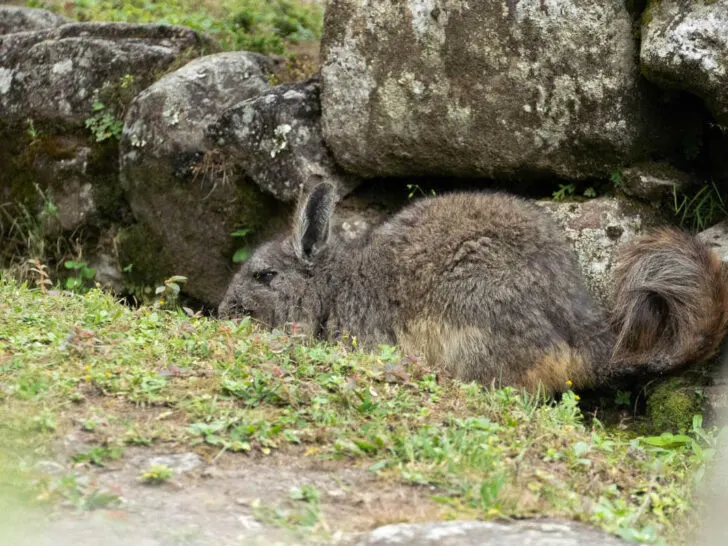
Day 1: Travel to Aguas Calientes in the morning and visit Machu Picchu that afternoon. You’ll enjoy Machu Picchu with “golden hour” lighting and without the crowds.
Day 2: Get up early and return to Machu Picchu for an add-on hike with impressive, panoramic views. Catch the train around noon and be back in Cusco in time for dinner.
Different ways to get to Machu Picchu
Getting from Cusco to Machu Picchu by train
- Cost: From $50 USD each way, train only
- Travel time: 1.5 hours from Ollantaytambo, 3.5-4 hours from Cusco, each way
- Trip duration: One day or 2D/1N
- Booking: Peru Rail or Inca Rail
Taking the train is the quickest and easiest way to get to Machu Picchu. It’s the only option if you have just one day.
Inca Rail is marginally cheaper, but Peru Rail has more scheduled trains. Only certain Peru Rail trains connect with Cusco.
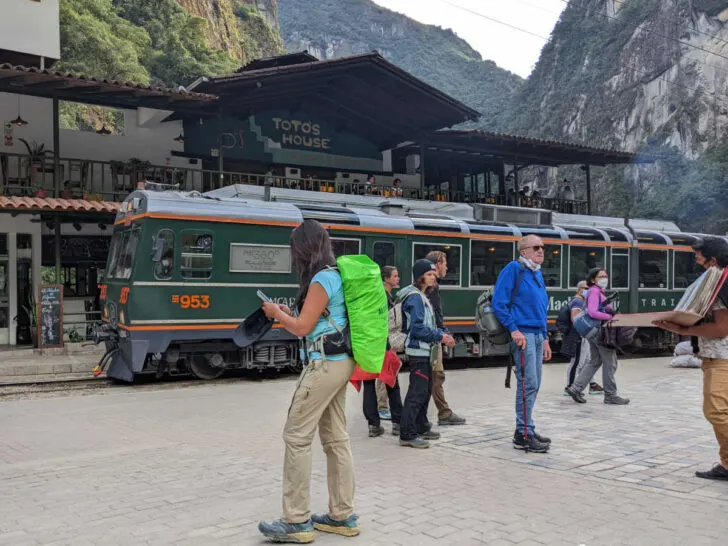
It’s important to note that Cusco trains:
- Only operate during dry season; from October through April, a bus connects Ollantaytambo and Cusco.
- Many services from/to Cusco start/end in Poroy, a 30-minute drive outside Cusco. You will need to arrange transport to/from the city center.
- The train ride between Cusco and Ollantaytambo takes 2-2.5 hours, compared to 1.5 hours by bus.
I recommend taking public transport (around $3.5 USD) or a taxi (from $25-30 USD) from Cusco to Ollantaytambo and then the train from there.
Train types
Both Inca Rail (IR) and Peru Rail (PR) have different levels of service, which vary in comfort and inclusions.
- Economy
- Name: Voyager (IR); Expedition Peru Rail (PR)
- Inclusions: Comfortable seats and standard-sized windows
- One-way price from Ollantaytambo: From $50 USD (IR) and $55 USD (PR)
- Premium
- Name: 360 Machu Picchu and Premium&Lounge (IR); Vistadome and Vistadome Observatory (PR)
- Inclusions: Larger windows for panoramic views, snacks, and onboard entertainment. IR 360 has an outdoor observatory balcony, while the PR Vistadome Observatory and the IR Premium&Lounge have covered observatory cars
- One-way price from Ollantaytambo: From $100 USD (IR), $85 USD (PR Vistadome), and $120 USD (PR Vistadome Observatory)
- Luxury
- Name: First Class (IR); Hiram Bingham (PR)
- Inclusions: Luxury seats, a gourmet meal and drinks, dining and observatory cars, onboard entertainment, a private bus, and a guide for Machu Picchu. Additionally, the Hiram Bingham includes the Machu Picchu entry ticket and cocktails at the Sanctuary Lodge
- One-way price from Ollantaytambo: From $345 USD (IR bimodal service) and $570 USD (PR)
My opinion on which train to take? Since it’s only a 1.5-hour train ride, I don’t see the value in spending extra on the premium and luxury options.
Note that you may only take carry-on size bags (up to 8kg) on all services. Most hotels in Cusco and the Sacred Valley will store your luggage free of charge while you travel.
Getting from Cusco to Machu Picchu by bus
- Cost: From $120 USD independently or $100 USD with an agency, including transport, entry tickets, and accommodation
- Travel time: Seven hours by bus each way, 2.5-3 hours hiking
- Trip duration: 2D/1N
- Further details: See our Machu Picchu on a budget article
This is the most budget-friendly option: the whole trip costs the same as return train tickets. It does involve a long, uncomfortable bus journey and some hiking though, so it’s not the best choice if you’d like a more relaxed route to Machu Picchu.
To keep it as cheap as possible, the costs listed above include very basic accommodation and food, but no bus tickets between Aguas Calientes and Machu Picchu ($12 USD one way). If booking through an agency, check the inclusions carefully.
Want a cheeky 5% discount on the Inca trail?
Alpaca Expeditions are not only one of the most sustainable companies offering Inca trail treks to Machu Picchu, but their guides, porters and chefs are the ultimate hosts.
They’re now offering Worldly Adventurer readers a 5% discount on all of their hikes – just mention Worldly Adventurer when you enquire!
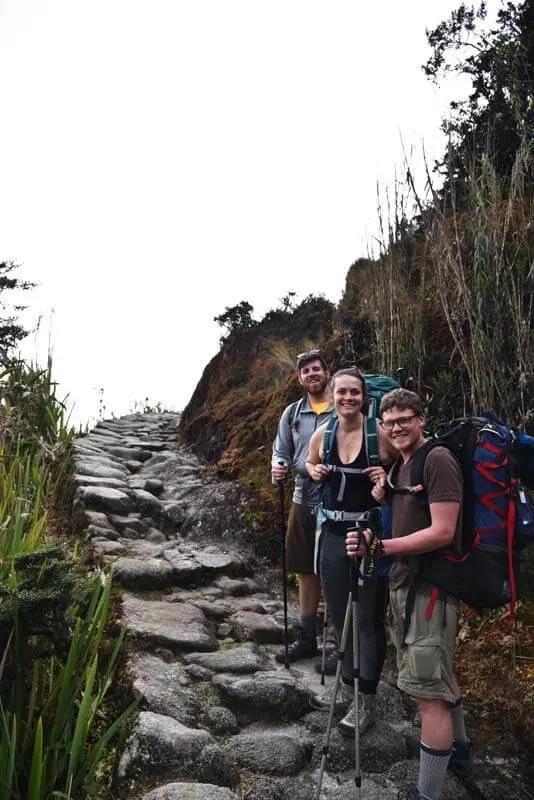
Read our how to visit Machu Picchu on a budget article for much more detailed information.
Hiking routes to Machu Picchu
1. The Classic Inca Trail
- Why do it: It’s the only way to hike into Machu Picchu (other than the short Inca Trail – see below). It follows a beautifully restored Inca trail through incredible scenery, an experience that recreates the hike to Machu Picchu under the Inca Empire.
- Distance and duration: 46 kilometers (28.6 miles) over 4D/3N.
- Difficulty: Moderate to hard.
- How to do it: Only possible with a licensed agency; tours are all-inclusive
- Start and end points: Cusco, from where you’ll be taken by bus to the trailhead, KM82. Trek ends at the Sun Gate, inside Machu Picchu.
- Price: From $780 USD; to ensure you get your spot (only 500 people are allowed on the Inca Trail daily and spaces get booked up six months in advance), book early with our recommended company, Alpaca Expeditions, who’ll give you a 5% discount on your trek if you use the code “Worldly Adventurer”.
- Further information: Permits are limited. For May-September dates, book at least six months in advance; November-April is quieter, but rain is likely. To ensure you get your spot, book in advance with our recommended company, Alpaca Expeditions, who’ll give you a 5% discount on your trek if you use the code “Worldly Adventurer”. The trail is closed during February. Read our in-depth Inca Trail article for details.
2. The Salkantay Trek
- Why do it: This trek takes you through incredible mountain scenery, past glacial lakes and into the cloud forest. The high point is 4,600 meters (15,090 feet), around 400 meters (1,312 feet) higher than the Inca Trail.
- Distance and duration: 70 kilometers (43.5 miles) over 4D/3N, plus a day in Machu Picchu.
- Difficulty: Moderate to hard.
- How to do it: Booking through an agency is easiest; however, it’s possible independently.
- Start and end points: Cusco, from where you’ll be taken by bus to the trailhead at Soraypampa. Trek ends in Aguas Calientes, where transportation to Machu Picchu and back to Cusco, plus accommodation, is included in guided tours.
- Price: From $500 USD for a tour, from $150 USD independently; Alpaca Expeditions will give you a 5% discount on your trek if you use the code “Worldly Adventurer”. They’re indigenous-owned, offer just wages to their porters, and provide a really incredible tour experience.
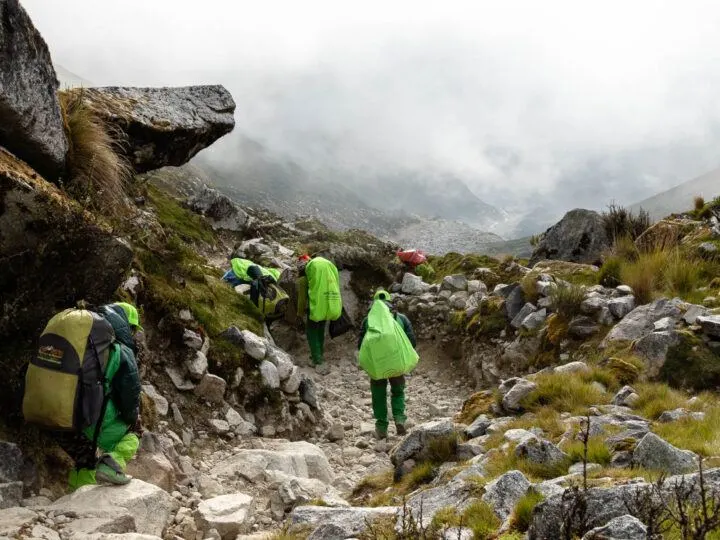
- Further information: No permits are required. You can book your tour in Cusco, but remember advance booking is necessary for Machu Picchu tickets. Open all year, but can get muddy during the rainy season. Learn more in our Salkantay trekking guide.
3. The Short Inca Trail
- Why do it: Experience hiking the Inca Trail, just without the camping, and visit the secluded Inca site of Wiñay Wayna.
- Distance and duration: 9 kilometers (5.6 miles) over one day; 2D/1N. Includes two visits to Machu Picchu.
- Difficulty: Moderate.
- How to do it: Only possible with a licensed agency; tours are all-inclusive
- Start and end points: Cusco, from where you’ll be taken by bus to the trailhead, KM104. Trek ends at the Sun Gate, inside Machu Picchu.
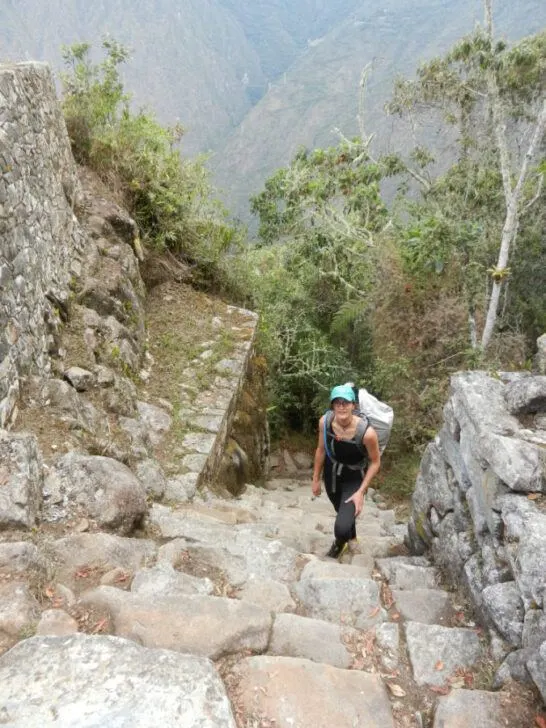
- Price: From $500 USD.
- Further information: Permits are limited, so book in advance. Book our local, indigenous-owned tour company, Alpaca Expeditions, who’ll give you a 5% discount on your trek if you use the code “Worldly Adventurer”. The trail is closed during February. You’ll enter Machu Picchu through the Sun Gate on day one, stay overnight in a hotel in Aguas Calientes, and then return to tour the site on day two.
4. The Lares
- Why do it: Get away from the crowds and experience life in high Andean communities. See snow-capped peaks, mountain lakes, native forests, and waterfalls.
- Distance and duration: 28-40 kilometers (17-25 miles) depending on the route over 3D/2N, plus a day in Machu Picchu.
- Difficulty: Moderate to hard.
- How to do it: Booking through an agency is easiest. Possible independently, but you need backpacking experience and gear.
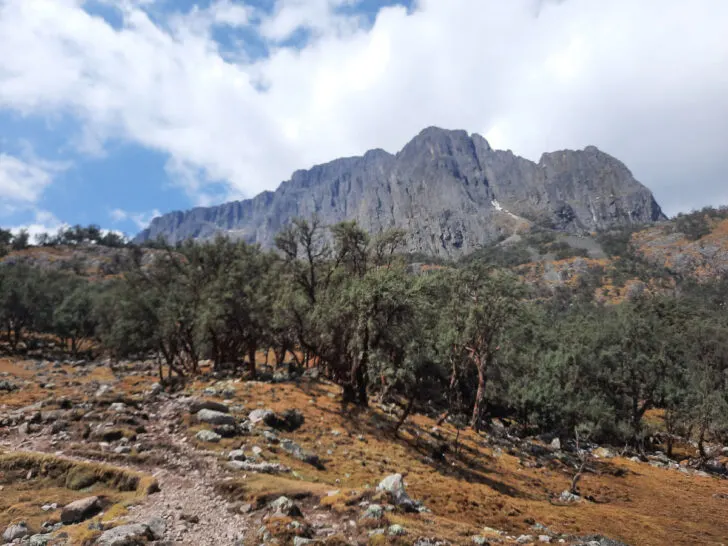
- Start and end points: Each route has different start and end points but is reachable by bus from Cusco. Despite being billed as an alternative trek to Machu Picchu, no routes actually finish close to the site. Instead, you’ll finish much closer to Ollantaytambo, from where you’ll need to take the train to reach Aguas Calientes and then the bus up to Machu Picchu.
- Price: From $400 USD for a tour, from $200 USD independently.
- Further information: The “Lares Trek” refers to several different routes between Lares and the Sacred Valley. No permits are required, so you can book a tour in Cusco, or turn up and hike. Machu Picchu tickets must be purchased in advance.
Getting to Machu Picchu from Aguas Calientes
There are two ways to get to Machu Picchu from Aguas Calientes:
Shuttle bus
- Cost: $12 USD, one way
- Duration: 20 minutes each way
- How to book: Online or at the Consettur office in Aguas Calientes
Shuttle buses depart at regular intervals from the main bus stop in Aguas Calientes from 5:30am. The last bus from the site descends at 5:30pm. You will only be allowed on an ascending bus if you have an entry ticket with a coinciding time slot.
The road up is narrow and winding, so sit close to the front if you’re prone to motion sickness.
On foot
- Cost: Free
- Distance: 3.5 kilometers (2.2 miles)
- Duration: At least one hour up and 45 minutes down
If you’re on a budget, or you just like hard exercise, the alternative is to walk. It’s a short but tough hike, climbing 400 meters (1,300 feet) across two kilometers (1.2 miles). The trail opens at 5am.
Catching the bus up and hiking down is a slightly less strenuous option and avoids queues. The steep trail can be tough on the knees though, especially if you’ve already hiked one of the mountains in Machu Picchu.
Planning your trip to Machu Picchu
What to book in advance
- Machu Picchu ticket: Purchase on the official website. Online booking fees can be avoided by buying in person in Cusco (here). Next-day tickets can be available in the office in Aguas Calientes but are not guaranteed. You should secure tickets as soon as possible to avoid disappointment, so online booking is the best option
- Train tickets: Book via the Inca Rail or Peru Rail websites. Purchase train tickets when you get your entry tickets to reserve the best schedules and prices
- Bus tickets to Machu Picchu: It’s easiest to buy them online. You can also purchase at the Consettur office in Aguas Calientes the day before your visit
- Organized tours: Book well in advance during high season
- Treks: Book the Short and Classic Inca Trails at least four months in advance for high season. Other treks can usually be booked on arrival in Cusco but you risk not being able to secure a Machu Picchu ticket or tickets for add-ons such as Huayna Picchu, which get booked up months in advance.
- Accommodation in Aguas Calientes: Booking in advance is a good idea during high season.
Which route should you choose?
Free roaming inside Machu Picchu has not been permitted since 2018. Instead, all visitors must follow one of ten prescribed routes (grouped into three different circuits), chosen at the time of ticket purchase.
All routes are one-way, so take your time, and your ticket only allows for one entry into the site and the route.
Because you can only pick one route within a circuit (more on that shortly – yes, it’s very confusing!), it’s important to think carefully about what you want to see, whether you prefer scenery and hiking, are looking to take the iconic photo of Machu Picchu with Huayna Picchu mountain be or want to get deep into the heart of Machu Picchu.
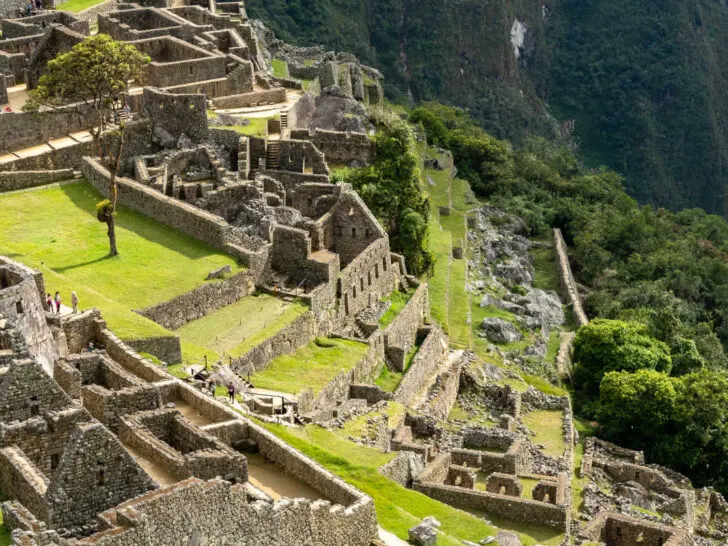
The route you choose also limits which parts of the ruins you can visit and has a suggested maximum time (shown in brackets below). Tickets have allocated entry times, so you must arrive at the entrance to the site at the corresponding time.
The cost also depends on the route you pick; unless indicated below, the ticket for entering Machu Picchu and doing your chosen route costs S/152 ($40 USD).
Yes, it’s pretty complicated, so it’s worth heading to the official booking website to see more information and to book your tickets. Bear in mind that the two most popular hiking routes, 1A (Machu Picchu Mountain) and 3A (Huayna Picchu Mountain), can get booked up four to six months in advance, while many of the other routes get booked up a couple of months in advance.
1. Panoramic Circuit
This circuit offers routes with the best scenic views of the site from the upper terraces – the iconic view of Machu Picchu from the Guardian House – but it doesn’t take you into the main temple area.
- 1A Machu Picchu Mountain (7 hours): Hike to the highest point of the site – with arguably the best views. It’s a 3.8-kilometer ( 2.4-mile) round trip with 650 meters (2,130 feet) of elevation gain, so you’ll need to be in good shape. Entry onto this route only at 7am and 9am; tickets cost S/200 ($53 USD).
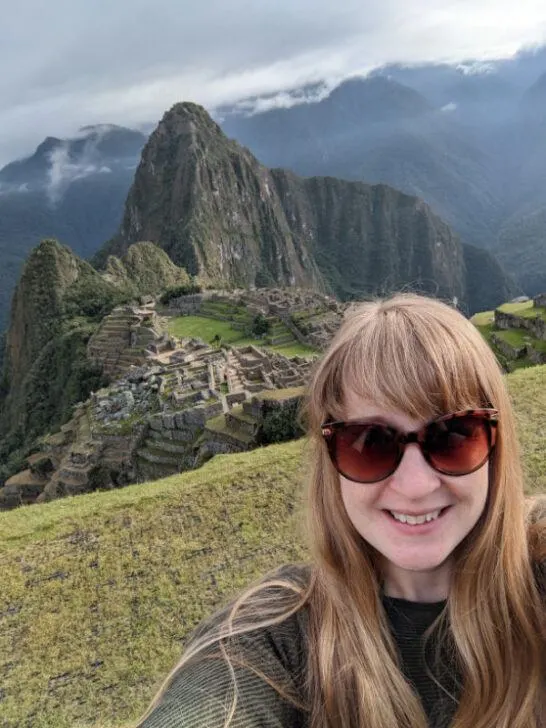
- 1B Upper Terraces only (2.5 hours): One of the shortest options, so better for people who can’t walk very far – although it does include a lot of stairs. Entry onto this route hourly between 6am and 3pm.
- 1C Sun Gate (4 hours): High season only. This route takes you to the Sun Gate (Inti Punku) where the Inca Trail enters the site. It’s less demanding than 1A, but has an awesome view. Entry onto this route only at 8am, 9am, 10am, and 11am.
- 1D Inca Bridge (3 hours): High season only. The shortest and easiest of the hikes, it takes you to Machu Picchu’s most dramatic entryway. Entry onto this route only at 8am, 9am, 10am, and 11am.
2. Classic Circuit
As its name suggests, this circuit offers two routes including most of the temples in the main site. Both routes (2A and 2B) are allocated 2.5 hours. The routes within this circuit offer the best scenic views and 2B goes slightly higher, giving it better panoramas. Entry onto both routes hourly between 6am and 3pm.
3. Royal Circuit
Perhaps the most varied, the routes within this circuit takes in the lower section of the main site and include three hiking options. All routes include the Sun Temple overlook, the room of mirrors and the Temple of the Condor.
- 3A Huayna Picchu Mountain (6 hours): Hike to the iconic peak (you’ll see it in the background of all the photos). The trail is very steep but short: you climb 290 meters (950 feet) over 1 kilometer (0.6 miles). Don’t do this if you’re scared of heights. Entry onto the circuit only at 7am and 9am; tickets cost S/200 ($53 USD).
- 3B Royal Route (2.5 hours): This route is designed for people with mobility issues as it is the shortest and with the fewest stairs. Entry onto this route hourly between 6am and 3pm.
- 3C Grand Cavern (7 hours): High season only. The trail leads to a hidden cavern, also known as the Temple of the Moon. You have to walk down a lot of stairs to get there, so be ready to climb back out! Entry onto the circuit only at 7am and 9am; tickets cost S/200 ($53 USD).
- 3D Huchuy Picchu (3.5 hours): High season only. This short hike up the hill next to Huayna Picchu gives decent views while being a more manageable climb. Entry onto the circuit only at 10am and 12pm; tickets cost S/200 ($53 USD).
Buying two tickets and visiting over two consecutive days will give you a deeper experience than a one-day visit. For example, do the Classic Circuit (2B) one afternoon and either Machu Picchu Mountain (1A), Huayna Picchu (3A) or Grand Cavern (3C) early the next morning.
When’s the best time to visit?
Month
The shoulder month between the wet and the dry seasons, Towards the end of the rainy season, April is my favorite time to visit Machu Picchu because everything is lush and green, the wildflowers are in full bloom, and there are fewer visitors.
May through September, however, is the most popular time to visit, because it’s the dry season. You’ll get great weather and little cloud cover across Huayna Picchu Mountain and the site as a whole, but there’s no escaping the crowds.
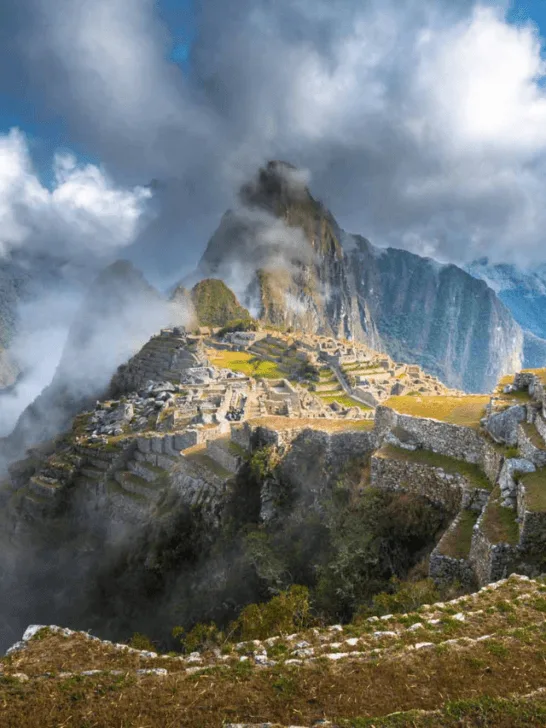
Rain is most likely during January through March, but showers are usually short-lived. Plus, mist floating over the site can be quite beautiful!
Time of day
Many people rush to visit Machu Picchu when the gates open at 6am, so they can “see the sunrise”. However, in the mountains, you don’t see the sun rising over the horizon – and it’s already light by 6am. But, seeing the first rays of sun hit Huayna Picchu can be special.
Going early also gives you more choice of circuits, because those including hikes are only available before 12pm. However, during the rainy season, the ruins can be shrouded in cloud early on. The afternoons are much quieter year round, so if you don’t like crowds, choose a later time slot.
What should you bring to Machu Picchu?
You’ll be on your feet the whole day, so it’s essential to wear comfortable shoes and lightweight clothing, particularly as temperatures can reach 25°C (77°F) during the day. Bring a warm jacket if visiting the site early in the day – as it can be a chilly 15°C (59°F) in the morning.
Take a small backpack with you, containing only what you need for the day, including:
- Your passport, Machu Picchu entry, and bus tickets
- Lightweight layers to adapt to changing weather conditions. Temperatures change a lot during the day and there’s always a chance of rain.
- A rain jacket
- Sunscreen, sunhat, and sunglasses
- Insect repellent – there are a range of different biting insects here
- Camera* or camera phone
- Cash in Peruvian Soles, including change for the bathroom and to pay for a Machu Picchu stamp for your passport, if desired
- Water and snacks – there is nowhere to buy these inside the site, and only a handful of very expensive places outside
Read our guide to packing for South America for recommendations for the different gear you need for Machu Picchu and beyond.
*Photography for commercial purposes requires a permit, so if you have a camera that looks really professional, you may not be allowed to take it in. Avoid bringing a tripod and a big bag full of equipment – otherwise, if you get a functionary in the wrong mood, you might get into problems.
There is a long list of things you can’t take into the ruins, but the important ones include:
- Large backpacks
- Long objects like walking sticks (unless you need them for medical reasons), selfie sticks, tripods, or umbrellas
- Alcohol, cigarettes, vapes or banned substances
For a full list and other rules, check the official code of conduct.
Do you need a guide to visit Machu Picchu?
Touring Machu Picchu with a guide is not obligatory. However, you will get more out of your visit with someone explaining what you are seeing.
Organized tours from Cusco usually include a guide, but levels of English and historical knowledge can vary, affecting how much you enjoy it. Booking through a reputable agency can ensure a good experience.
You can hire a guide at the gates of Machu Picchu, but again, quality differs widely. Ask a few questions before you commit to at least check language skills. Guides charge from $50 USD for private tours and $15 USD per person for group tours.
Looking for more information about Machu Picchu and how to plan a trip to this incredible archeological site? We’ve got guides to spending a few days in Cusco, hotel recommendations in the city for every budget, plus some recommendations for other places you shouldn’t overlook in Peru (most of which you’ve probably never heard of before!).
